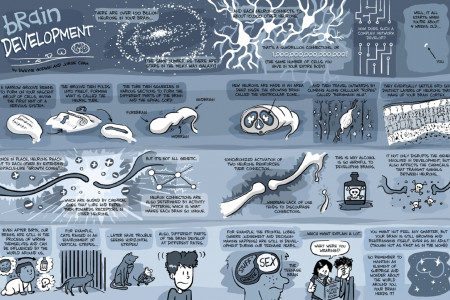
Understanding Schizophrenia
www.labroots.com [ from schizo- + Greek phrēn mind + -ia] SCHIZOPHRENIA AND KIDS Understanding Schizophrenia Schizophrenia is a serious psychiatric illness that causes strange thinking, strange feelings, and unusual behavior. It is uncommon In chlldren and hard to recognize in its early phases. Most cases of Schizophrenia are diagnosed between the ages of 18 - 35 and occurs in all societies regardless of class, colour, religion or culture. 22 DID YOU KNOW? MILLION Family Facts people suffer from Schizophrenia in the USA Schizophrenia tends to hit younger males hardest, with a much higher rate of hospitalization required between the ages of 15 and 40. After a person has been diagnosed with schizophrenia in a family, the chance for a sibling to also be diagnosed with schizophrenia i. Childhood-onset schizophrenia (COS), characterized by onset before age 13 years, has a prevalence of approx The earlier someone with schizophrenia is diagnosed and stabilized on treatment, 7-9% the better the long-term prognosis for their illness. 1 in 40,000. Approx, 50% of teens with the illness will be If a parent has schizophrenia, the chance for a child to have the disorder is 10 to 15 percent. Risks increase with multiple affected family members. at high risk of attempting suicide. Common MISCONCEPTIONS PEOPLE WITH SCHIZOPHRENIA HAVE MULTIPLE OR SPLIT PERSONALITIES According to a 2008 survey by the National Alliance on Mental Illness (NAMI), 64 percent either can't recognize its symptoms or think the symptoms include a "split" or multiple personalities. SCHIZOPHRENIA IS PURELY GENETIC Studies have shown that in pairs of identical twins (who share an identical genome) the prevalence of developing the illness is 48 percent.... Paranoia Genetics and environmental factors most likely play a significant role in the early onset of schizophrenia. But even without knowing precise causes, researchers believe certain risk factors may increase the risk of childhood onset schizophrenia. Decline in hygiene Unfounded anxiety and fear Withdrawn and isolated Extreme moodiness • History of first or second degree genetic relatives with schizophrenia Fragmented speech Chaotic thoughts • Mother became pregnant at an Hallucinations older age • Stressful living environment The behavior of children with Exposed to viruses while in the womb schizophrenia may change slowly over time. For example, children who used to enjoy relationships with others may start to become more shy or withdrawn and seem to be in their own world • Mother with severe malnourishment during pregnancy. • Taking psychoactive drugs during pre-teen and early teen years THE ZIKA VIRUS As of February 2016, there is evidence that Zika fever in pregnant women can cause abnormal brain development in their fetuses by mother-to-child transmission, which may result in miscarriage or microcephaly. It is not yet known whether Zika virus causes microcephaly. A link has been established with neurologic conditions in infected adults, including Guillain-Barré syndrome. Researchers suggest the virus closely resembles some infectious agents that have been linked to the development of schizophrenia. Illnesses in utero are widely believed to trigger debilitating mental illnesses. Schizophrenia is highest in people who were born in Winter and early Sspring.. Just after Flu Segson Countries like Brazil are ill equipped to deal with the potential consequences of mental illness and schizophrenia in young children that could be the consequence of the Zika virus... Initially, researchers paid little attention to the outbreak, but the information now is overwhelmeing and could result in an entire generation of children being affected. Tregtment OPTIONS Treatment options for children with schizophrenia have improved considerably in recent years. Physicians and mental health experts take a multi-faceted approach to treat schizophrenia in children and teens. A combination of medications, individual and family therapy, and specialized school programs result in better recovery outcomes for children and adolescents. Drugs to treat schizophrenia are called antipsychotic medications. This type of drug was first developed in the 1950s. They have proved to be highly successful in treating the symptoms of schizophrenia. The different types of antipsychotics work best on different symptoms of the disorder and are not addictive. There are over 15 new medications for the treatment of schizophrenia currently in development by different The drugs are not a cure for the disease, but they do reduce the symptoms. biotech and pharmaceuticals companies Egrly treatment is better as it seems to prevent serious complications. Of the population will 1% Develop Schizophrenia during their lifetime MEN WOMEN 40 Schizophrenia onset is quite rare for people under 10 years of age, or over 40 years of age. The diagram below demonstrates the general "age of onset" trends for schizophrenia in men and women, from a representative study on the topic 30 20 10 O 10 20 30 40 50 60 70 80 AGE AT ONSET IN SCHIZOPHRENIA Age at onset in years $61... BILLION Is spent a year for direct treatment, societal and family costs...but More than half of kids under the age of 16yrs suffering from the illness go undiagnosed Sources http://www.dubaichronicle.com https://www.nami.org/ http://www.ncbi.nlm.nih.gov http://faculty.washington.edu http://schizophrenia.com http://psychcentral.com http://www.aacap.org labroots http://www.healthyplace.com www.labroots.com http://www.who.int NUMBER OF ONSETS (per 5 years) EARLY ONSET SYMPTOMS CAUSES
Understanding Schizophrenia
Source
http://www.l...izophreniaCategory
ScienceGet a Quote








